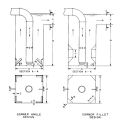Stilling Well Examples: Difference between revisions
From ASDSO Dam Safety Toolbox
(Created page with "<!--Example Page --> <div style= "text-align:center;"> <!-- Add message here --> ''Message: Examples of Stilling Wells'' </div> ----</br> <!-- Add body paragraphs here --> '''The advantages of a vertical stilling well include:''' *Minimal requirement for water levels within the downstream channel. *Adaptable to sites with limited space due to other infrastructure restrictions. *Inclusion of a sleeve valve may allow for more economy of savings than other alternatives. ''...") |
No edit summary |
||
| (2 intermediate revisions by the same user not shown) | |||
| Line 1: | Line 1: | ||
[[Category:Accounting for Energy Dissipation Outlet Works]] | |||
---- | |||
<!-- Add body paragraphs here --> | <!-- Add body paragraphs here --> | ||
'''The advantages of a vertical stilling well include:''' | '''The advantages of a vertical stilling well include:''' | ||
| Line 12: | Line 9: | ||
'''The disadvantages of the vertical stilling well include:''' | '''The disadvantages of the vertical stilling well include:''' | ||
*Requires a steel liner to reduce the potential for damage to the pedestal and lower portion of the chamber. In some cases, the anchorage for the steel liner has been determined to be underdesigned for the conditions actually experienced. | *Requires a steel liner to reduce the potential for damage to the pedestal and lower portion of the chamber. In some cases, the [[anchorage]] for the steel liner has been determined to be underdesigned for the conditions actually experienced. | ||
*Problems have been experienced with the valve operating mechanism due to turbulence in the stilling well. | *Problems have been experienced with the valve operating mechanism due to turbulence in the stilling well. | ||
*The typical valve and stilling well application is not well suited for use with high debris loads. | *The typical valve and stilling well application is not well suited for use with high debris loads. | ||
<gallery mode="slideshow" > | <gallery mode="slideshow" > | ||
<!-- Add image files here --> | <!-- Add image files here --> | ||
File:SW1.jpg|Typical Bureau of Reclamation stilling well application. | File:SW1.jpg|Typical [[Bureau of Reclamation]] stilling well application. | ||
File:SW2.jpg|This stilling well was installed in 1966 and consists of a 10-foot wide well, 16-foot depth, and a 24-inch diameter sleeve valve. Design discharge is 78 cfs at a static head of 88 feet. | File:SW2.jpg|This stilling well was installed in 1966 and consists of a 10-foot wide well, 16-foot depth, and a 24-inch diameter sleeve valve. Design discharge is 78 cfs at a static head of 88 feet. | ||
File:SW3.jpg|Stilling well at a conduit outlet. | File:SW3.jpg|Stilling well at a conduit outlet. | ||
| Line 25: | Line 22: | ||
</gallery> | </gallery> | ||
''Note: The content on this page was originally created as part of DamOutletWorks.org (DOWL, 2018). It has subsequently been updated and reformatted as part of the Dam Safety Toolbox.'' | |||
[[Category:Example Pages]] | [[Category:Example Pages]] | ||
{{Revhistinf}} | {{Revhistinf}} | ||
Latest revision as of 23:41, 14 December 2022
The advantages of a vertical stilling well include:
- Minimal requirement for water levels within the downstream channel.
- Adaptable to sites with limited space due to other infrastructure restrictions.
- Inclusion of a sleeve valve may allow for more economy of savings than other alternatives.
The disadvantages of the vertical stilling well include:
- Requires a steel liner to reduce the potential for damage to the pedestal and lower portion of the chamber. In some cases, the anchorage for the steel liner has been determined to be underdesigned for the conditions actually experienced.
- Problems have been experienced with the valve operating mechanism due to turbulence in the stilling well.
- The typical valve and stilling well application is not well suited for use with high debris loads.
Note: The content on this page was originally created as part of DamOutletWorks.org (DOWL, 2018). It has subsequently been updated and reformatted as part of the Dam Safety Toolbox.
Revision ID: 5759
Revision Date: 12/14/2022





